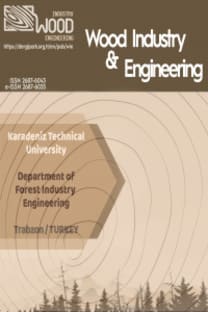THE EFFECT OF TRADITIONAL AND LASER CUTTING ON SURFACE ROUGHNESS OF WOOD MATERIALS USED IN FURNITURE INDUSTRY
One of the most important problems in the use of solid wood in the furniture industry is the surface roughness of the furniture elements depending on the cutting conditions. The required processes and efforts to obtain a smooth surface are too much, and besides the loss of time and raw materials in the production line, there are great costs in the creation of the machine park. In this study, the surface roughness of the materials obtained from some wood species processed with CNC laser and circular saw machine was investigated. Poplar (Populu scanadensis, scotch pine (Pinus sylvestres) and fir (Abies cilicica) samples were used as raw material in the study. Cutting processes were applied parallel and perpendicular to the fibers of the samples. In the cutting power of the CNC laser machine was kept constant as 130 watts and two different speeds were used at 10 mm/s and 20 mm/s. The rotation speed of the circular saw machine was adjusted as 4300 rpm without loading and the roughness rates of the traditional circular saw and CNC laser cut surfaces were compared. As a result, it has been determined that the laser cutting speed is directly proportional to the surface roughness. In addition, compared to traditional cutting, rougher surfaces were obtained in parallel cutting to fibers with CNC laser and smoother surfaces were obtained in perpendicular cutting to fibers. Consequently, it was concluded that it is more appropriate to use perpendicular cutting to fiber with CNC laser in the furniture industry.
Keywords:
CNC, Laser cutting surface roughness, wood materiel,
___
- Aydın, İ. and Çolakoğlu, G. (2003). "Roughness and Roughness Measurement Methods on Wood Surfaces" "Journal of Kafkas University Artvin Faculty of Forestry, 1-2:92-102.
- Barnekov, V. et al. (1989) '' Laser machining of wood composites '' Forest Products Journal, 39 (10): 76-78.
- Eltawahni, H.A. et al. (2011). '' Investigating the CO2 lasercutting parameters of MDF wood composite material''Optics & Laser Tecnology 43 (3) 648-659.
- Gaff, M. et al. (2020). '' Interactions Of Monitored Factors Upon Tensile Glue Shear Strength On Laser Cut Wood '' Composite Structures volume 234 -81116798:1-10.
- Kılıç, Y. and Demirci, S. (2003). "Investigation of the surface roughness of scotch pine and chestnut wood" Gazi University Journal of Science 16 -3: 553-558
- Örs, Y., and Baykan, İ. (1999). '' The Effects of Grating and Sanding on the Surface Roughness of Solid Wood Material '' of Agriculture and Forestry 23 Supplement -3, (577-582) TÜBİTAK.
- Peker, H. and Ulusoy, H. (2019). “Wood Materials and Surface Roughness” SETSCI Conference Proceedings, 4 -1:588-590.
- Tiryaki, S. (2014). "Factors Effective on Surface Roughness in Wood Processing" SDÜ Forest Faculty Journal, 15:176-182.
- ISSN: 2687-6043
- Başlangıç: 2017
- Yayıncı: Karadeniz Teknik Üniversitesi
Sayıdaki Diğer Makaleler
Ayhan AYTİN, Süleyman KORKUT, Nevzat ÇAKICIER
